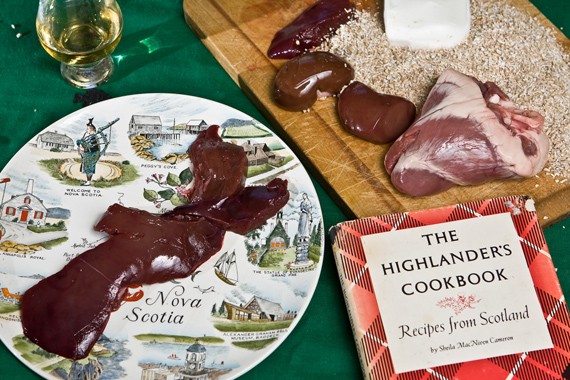Blame Robert Burns. He couldn't resist cracking wise about haggis when he tried to extoll its virtues and lauded its ugly pudding face with spoonfuls of self-deprecating irony in his ode. And at that moment, haggis stopped being food and started its career as a sentimental symbol of the hard luck Scot.
I'm setting out to restore gastronomic dignity to this offal pudding. Last Sunday, I served three---one store-bought, from Tony's in Antigonish, one professionally crafted from Fid, and one I cooked myself---to fifteen friends at a dinner party.
At my dinner, there were no speeches, just seven pounds of haggis surrounded with neeps and tatties. That's the opposite of most Burns nights in Canada, where protocol takes precendence over food.
At the Bicentennial theatre in Musquodoboit, for instance, Dena Redden, the event organizer, describes their 10-year-old traditions. "We pipe in the haggis and flame it." Wait a sec: flame it?
"Oh," she says, "we put brandy on it and set it on fire. After it's piped in, the piper and the toaster down shots of whisky. Over dinner, there's speeches, a toast to the lassies, a response from the lassies and recitations of Burns' poetry."
The Scots excel at edifying rituals that fill in the cultural gaps we've forgotten. In Scotland, you can buy it deep fried in a chip shop in Glasgow or from a high-end butcher like Findlay's of Portobello. Here it usually plays second fiddle on a plate and behaves like dressing. Redden serves eighty people with three kilos of haggis from Tony's meats in Antigonish. She gives each plate just one tablespoon as a side to the roast beef.
Tony's haggis was popular with my guests, but lost points for a synthetic casing that made its texture resemble an overpacked suitcase. Dan MacGillivray, Tony's general manager, said they used to do an old-style haggis, but it's too much trouble complying with federal food regulations to use stomachs now, especially when he sells 400 kg of haggis per year.
I spend Sunday afternoon hanging out in Chef Dennis Johnston's kitchen at Fid. There's a bucketful of stomach on the floor and Johnston is pushing beef suet through a meat grinder. He pulls the oats out of the oven, mixes them with the ground heart, liver, kidney and lungs. He adds allspice, nutmeg, red pepper flakes and cooking broth. Before the hour's up, I'm fisting a sheep stomach, nearly elbow deep in cold skin. The outside feels like a thick rubber glove, the kind you use to handle hazardous chemicals. The inside feels like wet shag carpet.
Johnston feels there's not a lot of room to experiment with the haggis because of its iconic status. For the the last seven years, he's done a Burns supper at Fid. "It's like turkey dinner. It has to be just so. It's the traditional meal of Scotland and it's only famous for Burns day."
"You cook the shit out of the stomach for six hours so it's edible. It gives much of the taste to the haggis." He's right---the stomach flavours the stuffing. I think it mellows the other offal. Johnston bought his clean and ready from Oulton's meats near Windsor.
I couldn't buy a stomach casing from the Farmers' Market, but Jody Graham, who runs the Graham Family Farm in Eastville, provided me with top-notch lamb's hearts, liver and kidneys. Three to four pounds cost $15. The abattoir she uses, Northumberland near Truro, wouldn't hand over the stomach or lungs unless I bought the whole lamb.
I took Johnston's advice and made it like a terrine. It was easy to make and filled the house with a rich, earthy aroma. (My recipe is online.) Using fresh offal made it the strongest tasting haggis I'd ever eaten, something you need to drink whisky with to compete with its brawn.
Just before dinner, I hop in the car and cross town to Fid. I knock on the kitchen door and I burst in as Johnston cools the haggis. He puts it on ice, slices a chunk off for me to take home. I burn rubber back to the party, like an organ thief in the night.
His haggis and my haggis get along like MacDonalds and Campbells, which means, not at all. They're like the two old ladies from different clans who come to Johnston's dinner every year. "They sit down at their table and lay down the cards that say what clan they're from to stake out their turf."
Maybe Burns was right, maybe there is something about this sonsie dish that encapsulates every trait in Scots' ethnic makeup. Mine's roughly cut and heavily spiced with cayenne and black pepper. It's got a livery temper and spoils for a fight. Sound familiar? Johnston's is delicate, almost sweet. The nutmeg and allspice guide the offal to a softer balance like, say, the Scottish Enlightenment.
The difference in tastes puts me at ease. The dish isn't on life support. History and tradition don't dictate its taste. Like its simple French cousin, boudin noir, haggis can have individual identities, even if it's only eaten cermonially once a year.
Finally, the main part of the haggis problem is a lack of self-confidence. Scottish cuisine? We usually feel like the kid who ate old gum off a telephone pole and only kept chewing out of a defensive pride.
But fellow Scotians, take heart. A trio of puddings converted my fellow foodies to the charms of haggis. Gastronome Ron Bates echoed the consensus at my Burns' night. "All of them required a little bit of a mental hurdle, because there was something gross about all of them. But they were still really tasty." I'll take that as a positive endorsement.

